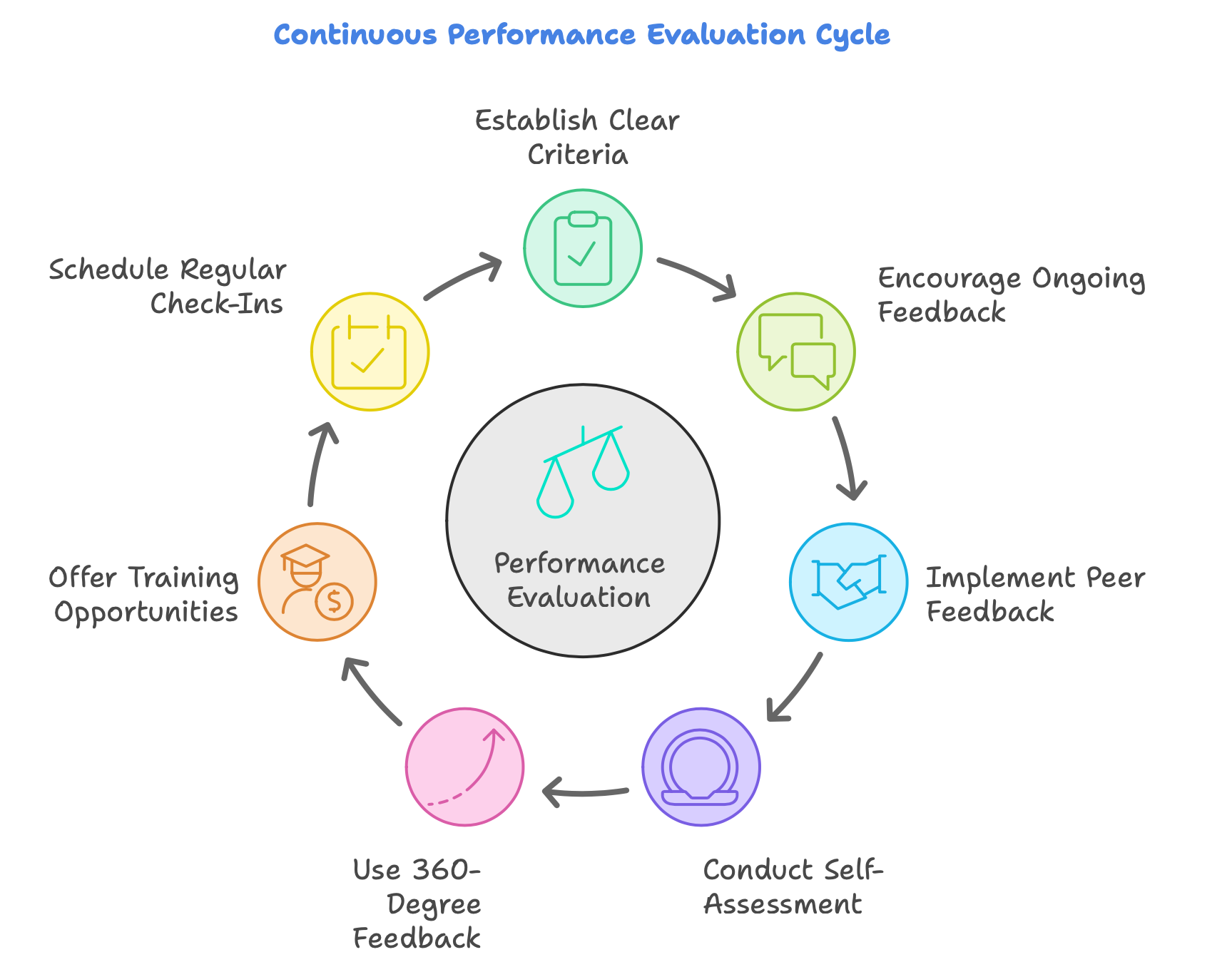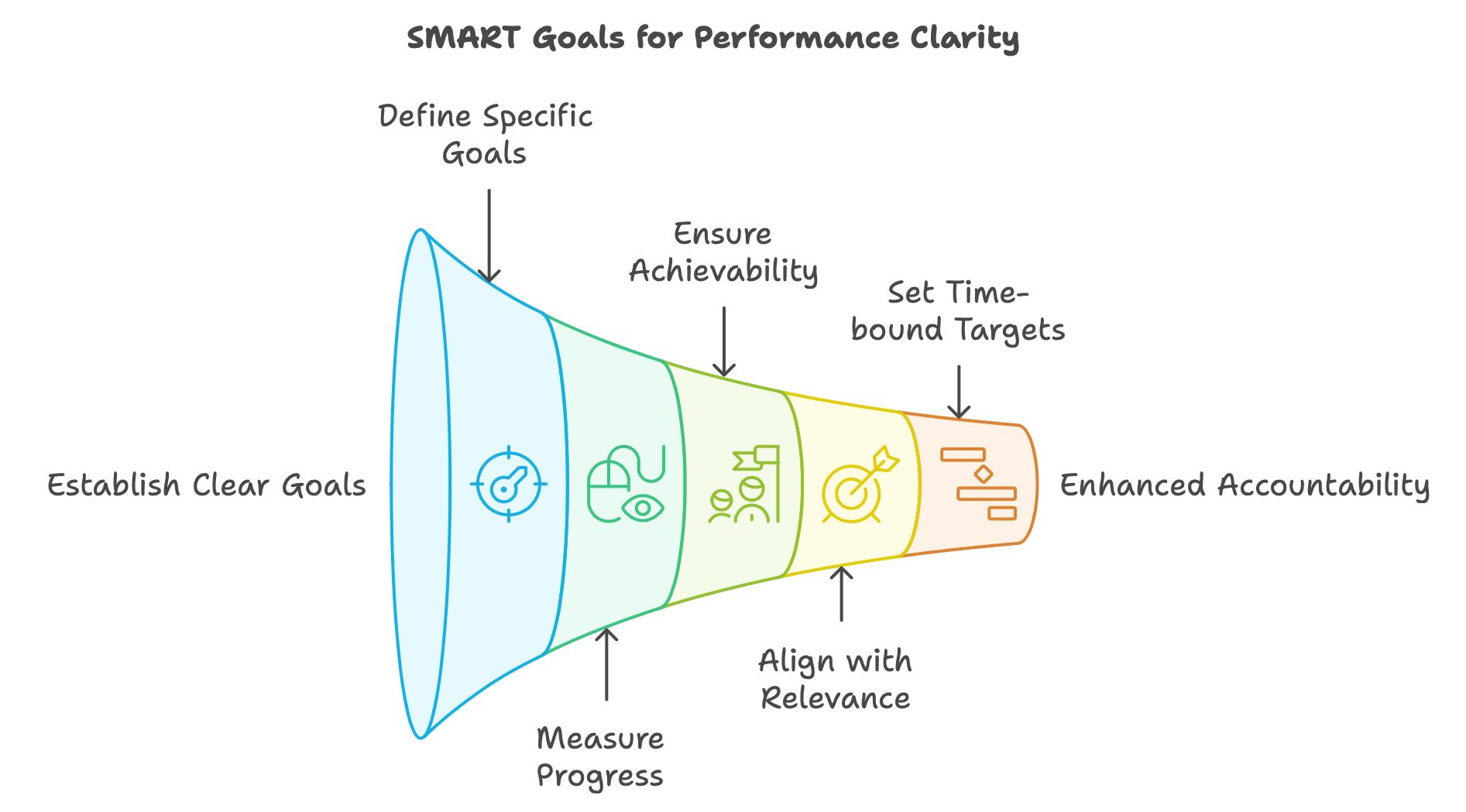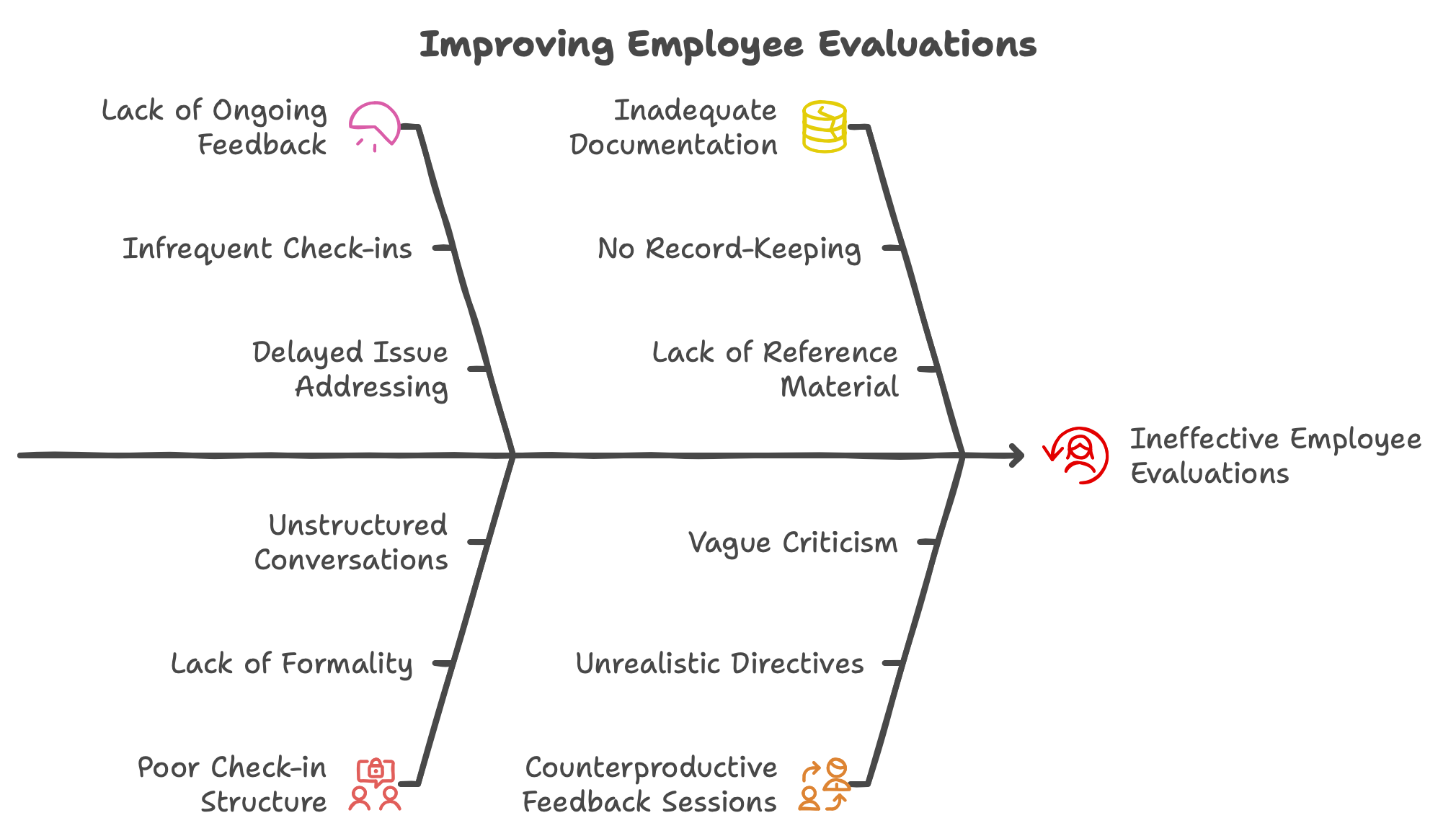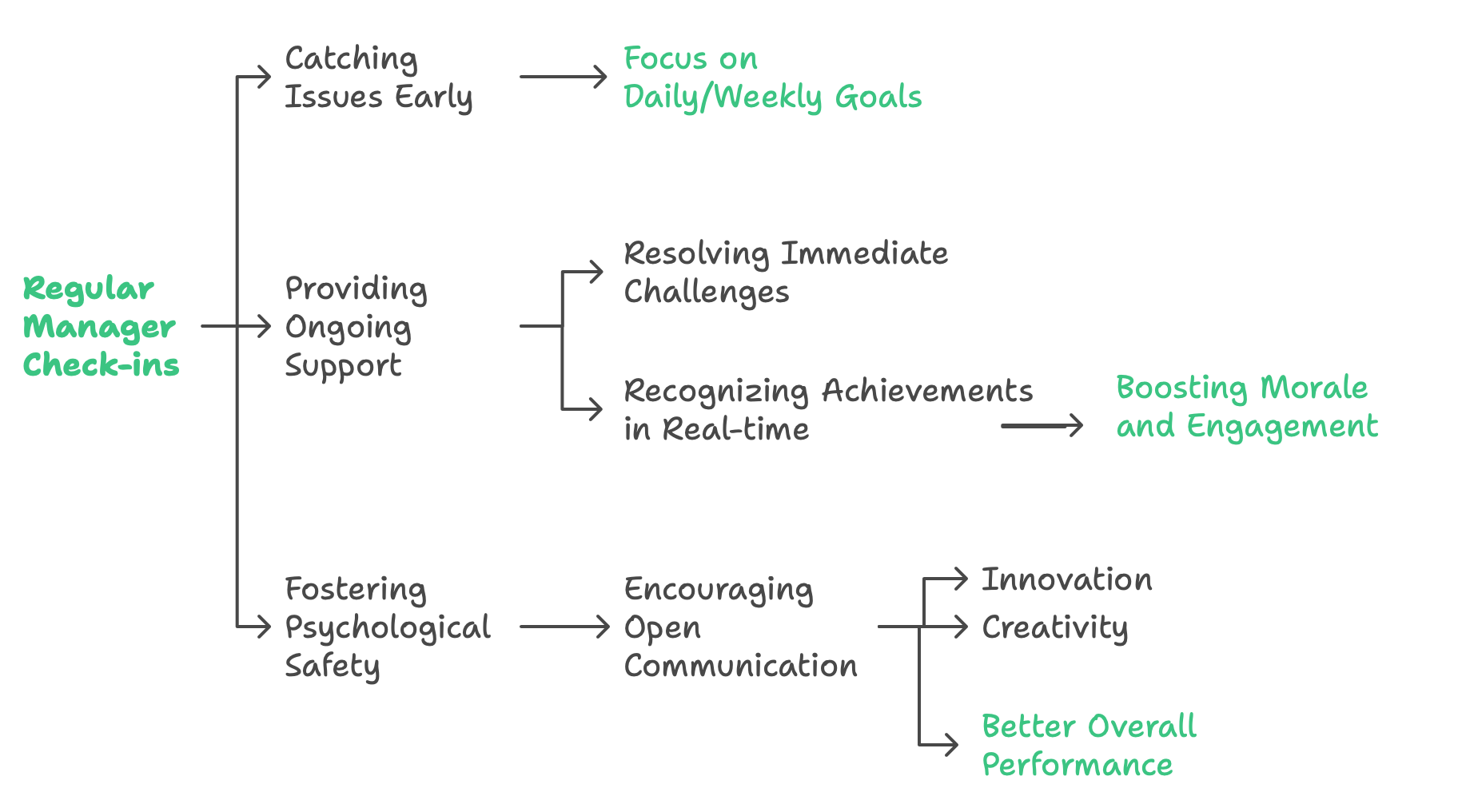Addressing Bias in Manager-Only Evaluations
When performance evaluations rely solely on a manager’s perspective, it can unintentionally introduce bias or overlook important aspects of an employee’s contributions.
Managers, while critical to the process, may not always observe the full range of an employee's performance, especially in collaborative roles or cross-functional teams.
Therefore, it's crucial to diversify feedback sources and create a more holistic view of employee performance.
This can be achieved by incorporating multiple evaluation methods, such as peer reviews, self-assessments, and customer feedback (for client-facing roles).
Managers, while critical to the process, may not always observe the full range of an employee's performance, especially in collaborative roles or cross-functional teams.
Therefore, it's crucial to diversify feedback sources and create a more holistic view of employee performance.
This can be achieved by incorporating multiple evaluation methods, such as peer reviews, self-assessments, and customer feedback (for client-facing roles).

By diversifying perspectives, you not only mitigate biases but also give employees a fairer opportunity to highlight achievements that might otherwise be missed.
Establishing Clear and Measurable Goals
One of the most effective ways to reduce subjectivity in performance reviews is to establish clear, measurable goals. When each employee understands exactly what is expected of them, it creates a more objective foundation for evaluation. These goals should align with broader company objectives while being tailored to the individual’s role and responsibilities.
SMART Goals for Enhanced Accountability
Using the SMART framework (Specific, Measurable, Achievable, Relevant, Time-bound) ensures that each goal is clear and provides a roadmap for success. This helps both managers and employees stay aligned on expectations.

For instance:
Role: Marketing Manager
Objective: Increase website traffic by 15% over the next quarter.
SMART Breakdown:
- Specific: Increase website traffic through targeted campaigns.
- Measurable: A 15% increase can be tracked via Google Analytics.
- Achievable: Based on prior quarters, a 15% increase is reasonable with enhanced SEO efforts and paid campaigns.
- Relevant: This aligns with the company’s goal to generate more online leads.
- Time-bound: The objective is to be completed within the next three months.
This method leaves little room for ambiguity and ensures that both parties can track progress clearly.

Encouraging Continuous Feedback Loops
One of the key ways to ensure effective employee evaluations is to establish ongoing feedback loops. Waiting for bi-annual or annual reviews to address performance issues or commend successes can be too little, too late. Instead, regular check-ins (monthly or quarterly) help keep both managers and employees on the same page, reducing the risk of surprises at formal evaluations.
These check-ins don’t need to be overly formal. A simple, structured conversation about current projects, challenges, and successes can provide clarity and foster better communication. Documenting these interactions is also vital, as it creates a running record that both parties can refer back to during formal reviews. I recommend you to read our article about Advantages of Negative Feedback
Overcoming Feedback Challenges
Sometimes, feedback sessions can become counterproductive if they’re not handled with care. For example, a manager might give unrealistic directives, or an employee might be critiqued for situations beyond their control. To avoid these pitfalls, it’s essential to focus on actionable insights rather than vague or unhelpful criticism.
For example: Instead of saying, “You need to work harder,” a more effective piece of feedback could be, “Let’s break down your project timelines to identify where additional support is needed.” This reframes feedback into a collaborative problem-solving session rather than a punitive discussion.
Integrating Peer Feedback and Self-Assessment
Peer feedback and self-assessment offer valuable perspectives on performance that can complement managerial evaluations. Peer reviews are especially useful in roles that involve collaboration, allowing employees to gain insights into how they contribute to team dynamics and projects.
Implementing Peer Feedback Mechanisms
To gather peer feedback effectively, create a confidential, structured process that encourages honesty without fear of backlash. For example, you could use a survey tool with questions like:
- How well does this employee collaborate with others?
- Are they meeting their role’s expectations within the team?
- What are their greatest strengths?
- What’s one area where they could improve?

Similarly, self-assessments can help employees reflect on their own performance. Encourage them to evaluate their accomplishments, challenges, and areas for growth. This helps them take ownership of their development and may reveal blind spots managers weren’t aware of.
360-Degree Feedback: A Holistic Approach
Incorporating 360-degree feedback can further enhance the evaluation process by including input from all angles: managers, peers, direct reports, and even external stakeholders (e.g., clients or vendors). This method paints a fuller picture of the employee’s strengths and areas for development.
For example, in a customer service role, gathering feedback from clients on communication skills, problem resolution, and responsiveness can provide unique insights that may not be visible to managers alone.
Offering Development Opportunities
Performance evaluations shouldn't solely focus on what an employee has or hasn’t achieved; they should also pave the way for future growth. By offering training and development opportunities, companies not only show their investment in the employee but also help them bridge skill gaps and contribute more effectively to the organization.
You can tailor development plans based on the evaluation findings. For instance, if an employee’s communication skills are lacking, offer them workshops or courses on public speaking or effective email writing. If their technical skills need sharpening, suggest relevant certifications or mentorship within the company.
Regular Manager Check-ins: An Essential Practice
Even if formal reviews are scheduled infrequently, regular manager check-ins provide an opportunity to catch issues early and provide ongoing support. These check-ins can focus on daily or weekly goals, resolving immediate challenges, and ensuring the employee feels supported. They also offer a chance to recognize achievements in real-time, which can boost morale and engagement.

The Importance of Psychological Safety
During these check-ins, it’s important to foster psychological safety—the belief that employees can speak openly without fear of retribution. Employees should feel comfortable discussing challenges, asking for help, and offering feedback to their managers. This culture of trust encourages innovation, creativity, and transparency, all of which lead to better overall performance.
Final Thoughts
Ultimately, creating a fair and effective performance evaluation process requires more than just occasional reviews. By implementing continuous feedback loops, utilizing peer and 360-degree feedback, and establishing clear performance criteria, companies can foster a culture of transparency and growth.
Regular development opportunities and check-ins further ensure that employees feel supported and are given the tools they need to succeed. I also recommend you to read our article: The Future of Leadership: Creating Communities Over Command
Regular development opportunities and check-ins further ensure that employees feel supported and are given the tools they need to succeed. I also recommend you to read our article: The Future of Leadership: Creating Communities Over Command
How UnitiQ's Fractional HR Services Can Enhance Your Performance Review Process
UnitiQ’s Fractional HR Services offer the flexibility and expertise needed to improve your company’s performance evaluation processes. Whether you’re looking to implement regular performance reviews, establish measurable goals, or create a 360-degree feedback system, our team of HR experts is available on-demand to help.
We specialize in streamlining HR operations, ensuring fair and unbiased evaluations, and aligning your talent strategy with company values. With our sector-specific experts and fresh, external perspective, UnitiQ ensures that your performance reviews are comprehensive, transparent, and effective, all without the expense of a full-time HR team hire.
We will be happy to help you with Talent Acquisition and HR tasks, please contact me, Olga Fedoseeva, Fonder at UnitiQ, directly:
My Telegram
My LinkedIn
We specialize in streamlining HR operations, ensuring fair and unbiased evaluations, and aligning your talent strategy with company values. With our sector-specific experts and fresh, external perspective, UnitiQ ensures that your performance reviews are comprehensive, transparent, and effective, all without the expense of a full-time HR team hire.
We will be happy to help you with Talent Acquisition and HR tasks, please contact me, Olga Fedoseeva, Fonder at UnitiQ, directly:
My Telegram
My LinkedIn
